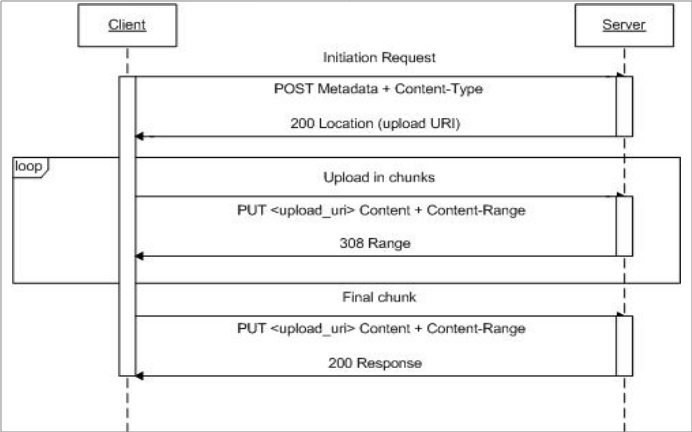Page Summary
-
The Google API Client Library for Java supports direct and resumable media uploads.
-
Resumable media upload is used for large files, sending them in chunks and reducing failure chances compared to direct upload.
-
The main classes for media upload are MediaHttpUploader and MediaHttpProgressListener.
-
Direct media upload sends the entire file in a single request and is enabled by setting
mediaHttpUploader.setDirectUploadEnabled(true).
This document describes how to use direct and resumable media uploads with the Google API Client Library for Java.
Resumable media upload
When you upload a large media file to a server, use resumable media upload to send the file chunk by chunk. The Google API generated libraries contain convenience methods for interacting with resumable media upload.
The resumable media upload protocol is similar to the resumable media upload protocol described in the Google Drive API documentation.
Protocol design
The following sequence diagram shows how the resumable media upload protocol works:

Implementation details
The main classes of interest are MediaHttpUploader and MediaHttpProgressListener.
If methods in the service-specific generated libraries contain the mediaUpload
parameter in the Discovery document,
then a convenience method is created for these methods that takes an
InputStreamContent
as a parameter. (For more about using media upload with the Google APIs
Discovery Service, see
Media upload.)
For example, the insert method of the Drive API
supports mediaUpload, and you can use the following code to upload a file:
class CustomProgressListener implements MediaHttpUploaderProgressListener { public void progressChanged(MediaHttpUploader uploader) throws IOException { switch (uploader.getUploadState()) { case INITIATION_STARTED: System.out.println("Initiation has started!"); break; case INITIATION_COMPLETE: System.out.println("Initiation is complete!"); break; case MEDIA_IN_PROGRESS: System.out.println(uploader.getProgress()); break; case MEDIA_COMPLETE: System.out.println("Upload is complete!"); } } } File mediaFile = new File("/tmp/driveFile.jpg"); InputStreamContent mediaContent = new InputStreamContent("image/jpeg", new BufferedInputStream(new FileInputStream(mediaFile))); mediaContent.setLength(mediaFile.length()); Drive.Files.Insert request = drive.files().insert(fileMetadata, mediaContent); request.getMediaHttpUploader().setProgressListener(new CustomProgressListener()); request.execute();
You can also use the resumable media upload feature without the service-specific generated libraries. Here is an example:
File mediaFile = new File("/tmp/Test.jpg"); InputStreamContent mediaContent = new InputStreamContent("image/jpeg", new BufferedInputStream(new FileInputStream(mediaFile))); mediaContent.setLength(mediaFile.length());MediaHttpUploader uploader = new MediaHttpUploader(mediaContent, transport, httpRequestInitializer); uploader.setProgressListener(new CustomProgressListener()); HttpResponse response = uploader.upload(requestUrl); if (!response.isSuccessStatusCode()) { throw GoogleJsonResponseException(jsonFactory, response); }
Direct media upload
Resumable media upload is enabled by default, but you can disable it and use direct media upload instead, for example if you are uploading a small file. Direct media upload was introduced in the 1.9.0-beta version of the Google API Client Library for Java.
Direct media upload uploads the whole file in one HTTP request, as opposed to the resumable media upload protocol, which uploads the file in multiple requests. Doing a direct upload reduces the number of HTTP requests but increases the chance of failures (such as connection failures) that can happen with large uploads.
The usage for direct media upload is the same as what is described above for resumable media upload, plus the following call that tells MediaHttpUploader to only do direct uploads:
mediaHttpUploader.setDirectUploadEnabled(true);